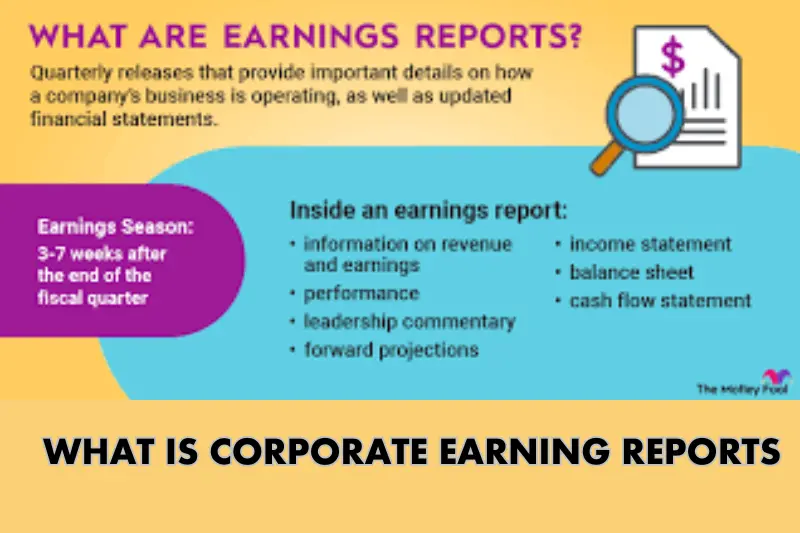Introduction:
Corporate earnings reports are official documents that companies publish to share their financial performance with the public. These reports usually come out every three months (quarterly) and sometimes annually. They include important information like how much money the company earned (revenue), how much it spent (expenses), and what’s left after costs (profit or loss).
These reports are very important for investors, financial analysts, and even regular people who want to understand how a company is doing. Think of corporate earnings reports as a “report card” for a business. Just like students get grades to show how well they’re doing in school, companies use earnings reports to show how well their business is performing in the market.
Corporate earnings reports also include data like earnings per share (EPS), which shows how much profit is made for each share of stock. This helps shareholders see if their investment is growing or not. Many people use these reports to decide whether they should buy more shares, sell them, or hold onto them.
In short, corporate earnings reports are key to understanding a company’s financial health. Whether you’re an investor, a business student, or just someone curious about how big companies operate, knowing how to read and understand corporate earnings reports can be a big advantage.
In this blog post, we’ll explain everything you need to know about corporate earnings reports in a simple, easy, and clear way—so you can make smarter financial choices.
You May Also Like It:
Hollywood Gossip: Latest Celebrity News, Drama,
TV Show Updates – Latest Episodes, New Seasons, Cast News
Entertainment Headlines – Latest Buzz from Movies
What is Corporate Earnings Reports?

Corporate earnings reports are official financial documents that companies release—usually every three months (quarterly) or once a year—to show how their business is performing.
These reports give a full picture of a company’s financial health. They include important information such as:
Revenue – the total money a company made during the period
Expenses – the money the company spent to run the business
Net income (profit or loss) – what’s left after expenses are subtracted from revenue
Earnings per share (EPS) – the profit assigned to each share of stock
Future outlook or guidance – what the company expects in the next quarter or year
Public companies (those listed on the stock market) are legally required to release these reports so investors and the public can stay informed.
In simple words, corporate earnings reports are like a business’s financial report card. They help everyone—from small investors to large institutions—understand how well the company is doing and what to expect going forward.
Why Corporate Earnings Reports Are Important

Corporate earnings reports are crucial tools for understanding how a company is performing. They offer insights that help investors, business leaders, and analysts make informed decisions. Here’s why these reports are so important:
Help Investors Make Smart Decisions
- Provide clear data on a company’s profits, revenue, and expenses
- Allow investors to decide whether to buy, hold, or sell stocks
- Enable comparison with past performance or other companies in the industry
Improve Transparency
- Ensure that companies remain accountable to shareholders
- Build trust with investors and the general public
- Reduce the chances of hidden financial issues
Track Business Growth
- Show whether a company is growing, stable, or declining
- Reveal trends in sales, operational costs, and overall performance
- Help businesses plan and adjust strategies accordingly
Impact Stock Prices
- Strong earnings often lead to higher stock prices
- Weak or disappointing results can cause stock prices to drop
- Earnings reports can affect the entire stock market
Essential for Analysts and Media
- Analysts use the data to make financial forecasts and investment recommendations
- Business media rely on reports for accurate financial reporting
- Help shape public and investor sentiment
Useful for Competitor Comparison
- Make it easier to compare performance across companies in the same sector
- Highlight market leaders and underperformers
- Support strategic planning based on industry benchmarks
You May Also Like It:
Geopolitical Conflicts: Learn the Basics in Easy Language
International Headlines: Stay Updated with the Late
Step-by-Step Guide on Corporate Earnings Reports
Understanding corporate earnings reports may seem complex at first, but with a few simple steps, anyone can learn how to read and benefit from them. Here’s a step-by-step guide:
Step 1: Know When the Report Is Released
- Public companies release earnings reports quarterly (every 3 months) and annually.
- Check the company’s investor relations page or financial news websites to know the earnings release date.
Step 2: Download or View the Earnings Report
- Visit the company’s official website under the “Investors” or “Financials” section.
- Reports are often labeled as 10-Q (quarterly) or 10-K (annual) for U.S. companies.
Step 3: Read the Key Sections
Focus on these important parts of the report:
- Income Statement – Shows revenue, expenses, and net profit/loss.
- Balance Sheet – Lists assets, liabilities, and equity.
- Cash Flow Statement – Explains how money flows in and out of the company.
- Earnings Per Share (EPS) – Indicates how much profit is made per share.
- Management Discussion & Analysis (MD&A) – Gives a plain-language summary of business performance and future plans.
Step 4: Compare with Previous Reports
- Compare this quarter’s results with the previous quarter and same quarter last year.
- Look for growth trends or signs of financial problems.
Step 5: Compare with Market Expectations
- Financial analysts give earnings forecasts before reports are released.
- If a company beats expectations, it’s usually a good sign; if it misses, the stock may drop.
Step 6: Listen to the Earnings Call (Optional)
- Many companies hold a live conference call with investors and analysts.
- This gives extra insights into the numbers and lets you hear directly from company executives.
Step 7: Make Informed Decisions
- Use the information to decide whether to buy, sell, or hold a stock.
- Don’t rely only on one report—look at the bigger picture and long-term performance.
Advantages and Disadvantages of Corporate Earnings Reports
| ADVANTAGES | DISADVANTAGES |
| Provide a clear view of a company’s financial health | Can be complex and hard to understand for beginners |
| Help investors make informed decisions about buying or selling stocks | Focus on short-term results, not long-term potential |
| Increase transparency and build trust with shareholders | Companies may use accounting tricks to make results look better |
| Allow comparison between companies in the same industry | Stock prices may react too strongly to small changes in results |
| Reveal important trends in revenue, profit, and expenses | Earnings can be influenced by one-time events, not core business performance |
| Offer insights through management commentary and future outlook | Reports may be delayed or lack honest future guidance |
Frequently Asked Questions (FAQs) on Corporate Earnings Reports
What is a corporate earnings report?
A corporate earnings report is a financial statement released by a company to show how much money it made, spent, and earned during a specific time—usually every 3 months.
Why are corporate earnings reports important?
They help investors and the public understand how well a company is doing. This helps people make smart decisions about buying, holding, or selling company stocks.
How often are corporate earnings reports released?
Most companies release them quarterly (every 3 months) and also provide a full-year report at the end of the year.
Who uses corporate earnings reports?
Investors, financial analysts, media, business leaders, and even regular people who are interested in the company’s performance use these reports.
Where can I find a company’s earnings report?
You can find it on the company’s official website under the “Investor Relations” section, or on financial news websites.
What are the most important parts of the report to read?
Key parts include the income statement, earnings per share (EPS), revenue, net profit, and the management discussion.
Do corporate earnings reports affect stock prices?
Yes. If the company does better than expected, the stock price usually goes up. If it does worse, the stock price may drop.
Can regular people understand earnings reports?
Yes! With a little practice and basic knowledge, anyone can understand the main points of an earnings report.
Conclusion:
Corporate earnings reports are much more than just numbers—they tell the full story of how a company is performing. They show whether a business is making money, spending wisely, and growing over time. These reports are released regularly and give everyone, from big investors to everyday people, a chance to see what’s really happening inside a company.
By learning how to read and understand corporate earnings reports, you can make better financial choices. You’ll be able to spot companies that are growing, avoid those that are struggling, and feel more confident about your investment decisions.
At first, earnings reports might seem confusing or full of financial terms. But once you know what to look for—like revenue, profit, expenses, and earnings per share—they become much easier to understand. Over time, they can become one of your best tools for making smart decisions in the stock market or business world.
In short, corporate earnings reports help you stay informed, reduce risks, and take control of your financial future.
Bonus Points on Corporate Earnings Reports
- Reports Influence Market Trends: Big companies’ earnings reports can impact not just their own stock price, but also the entire stock market.
- Guidance Matters: Many companies include future predictions (called “guidance”) in their reports. This is a big clue about what the company expects in the next quarter or year.
- Watch for Red Flags: A sudden drop in revenue or rising debt can be warning signs. Earnings reports help spot these issues early.
- Consistent Growth is Key: One good report is great—but look for consistent performance over time to judge a company’s real strength.
- Seasonal Effects: Some businesses perform better during certain times of the year (like retailers during holidays). Keep this in mind when reading reports.
- Use with Other Research: While earnings reports are important, always combine them with other research like market news, competitor performance, and industry trends.
- Earnings Calls Add More Info: Listening to or reading summaries of earnings calls (meetings where executives discuss the report) can give deeper insights that aren’t in the written report.
You May Also Like It:




